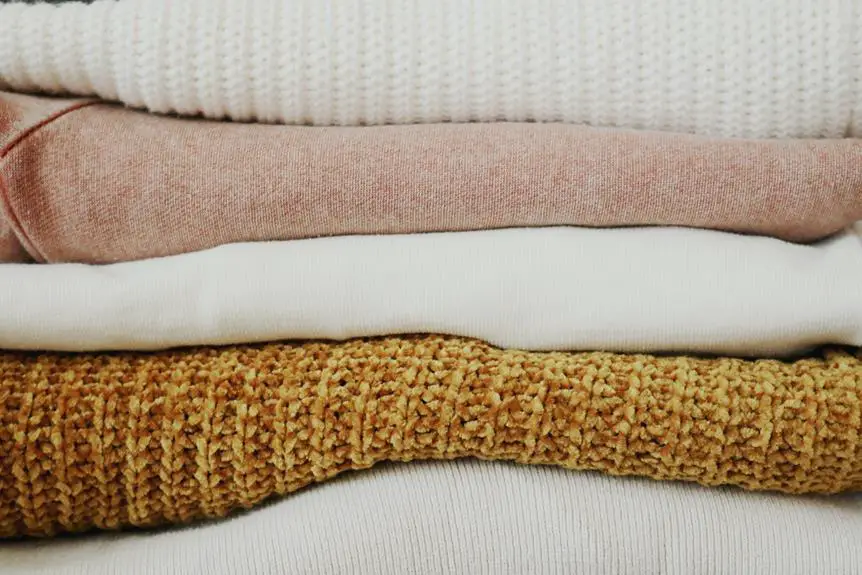Wondering if clothes sanitizer spray is safe for your fabrics? You're not alone. With the rise in demand for hygiene products, the use of clothes sanitizer spray has increased by 30% in the past year. Understanding its impact on different fabric types and safe application techniques is crucial for maintaining the integrity of your garments.
In this guide, we'll delve into the effectiveness of clothes sanitizer spray against odors and germs, while also exploring potential risks to fabric integrity and its compatibility with delicate fabrics. By the end, you'll have a clear understanding of the precautions and best practices for using clothes sanitizer spray on your beloved fabrics.
Key Takeaways
- Clothes sanitizer spray has seen a 30% increase in demand in the past year.
- Choosing a clothes sanitizer spray designed for different fabric types ensures fabric safety.
- Sanitizer sprays containing harsh chemicals may cause discoloration on certain fabrics.
- Clothes sanitizer spray effectively eliminates odors and germs when applied correctly.
Understanding Clothes Sanitizer Spray
You should understand how clothes sanitizer sprays work to effectively eliminate germs and bacteria from your garments. When using a clothes sanitizer spray, it's important to consider the fabric safety and the effectiveness of the sanitizer.
These sprays typically contain active ingredients that target and kill bacteria and germs present on your clothes. The effectiveness of the sanitizer comes from these active ingredients, which are designed to neutralize and eradicate harmful microorganisms. Understanding the specific components in the sanitizer can give you insight into how it works to ensure the cleanliness of your clothes.
When it comes to fabric safety, it's essential to choose a clothes sanitizer spray that's suitable for the materials of your garments. Many sanitizers are formulated to be gentle on fabrics while still providing powerful germ-killing properties. By considering the fabric safety and choosing a sanitizer designed for various types of materials, you can effectively sanitize your clothes without compromising their integrity.
It's important to follow the instructions provided with the sanitizer to ensure that you're using it correctly and safely for your garments.
Impact on Different Fabric Types
Hey there!
Now, let's talk about how clothes sanitizer spray can impact different fabric types.
You might be wondering how this sanitizer affects different materials, and if it's safe to use on all of your clothing.
We'll explore the compatibility of different fabrics with the sanitizer and any potential damage it could cause.
Fabric Compatibility With Sanitizer
Different fabrics react differently to clothes sanitizer spray, impacting their durability and colorfastness. When considering fabric care and sanitizer application, it's crucial to understand how different fabrics may respond.
Here's how various fabric types are impacted by clothes sanitizer spray:
- Natural Fabrics
- Cotton: Sanitizers are generally safe for cotton, but repeated use may cause some color fading.
- Silk: Sanitizer application on silk should be done with caution as it may affect the fabric's sheen.
- Synthetic Fabrics
- Polyester: Clothes sanitizer spray is usually safe for polyester, but excessive use could lead to fabric weakening.
- Nylon: Sanitizers are generally compatible with nylon, but it's essential to spot-test in inconspicuous areas first.
Understanding how different fabrics interact with clothes sanitizer spray can help you make informed decisions when caring for your garments.
Potential Damage to Fabrics
When considering clothes sanitizer spray, be mindful of its potential impact on various fabric types. Different fabrics may react differently to sanitizer sprays, and it's important to understand the potential risks. Sanitizer sprays containing harsh chemicals may cause potential discoloration on certain fabrics, especially those with delicate dyes. Additionally, the chemicals in the sanitizer spray could lead to fabric weakening over time, particularly on more delicate fabrics. To help you understand how different fabric types may be impacted, refer to the table below:
| Fabric Type | Potential Discoloration | Fabric Weakening |
|---|---|---|
| Cotton | Low | Low |
| Silk | High | High |
| Wool | Medium | Medium |
| Polyester | Low | Low |
Understanding how sanitizer sprays may affect different fabrics can help you make informed decisions when using them.
Safe Application Techniques
You should always carefully follow the instructions on the clothes sanitizer spray label to ensure safe and effective application. Proper and safe handling of the clothes sanitizer spray is essential for both your safety and the protection of your fabrics.
Here are some key application techniques to keep in mind:
- Spray Distance: Hold the sanitizer spray bottle at the recommended distance from the fabric surface. This ensures even distribution without saturating the fabric excessively, which can help in fabric protection.
- *Imagery*: Picture yourself holding the spray bottle about 6-8 inches away from the fabric, ensuring a light and even mist covers the surface without drenching it.
- Even Application: Move the spray in a steady, sweeping motion across the fabric. Avoid concentrating the spray on one area for too long to prevent over-saturation.
- *Imagery*: Imagine the spray moving gracefully back and forth, like a gentle breeze, ensuring that every part of the fabric receives an even mist.
Effectiveness Against Odors and Germs
To ensure the effectiveness of the clothes sanitizer spray against odors and germs, it's crucial to understand how its application techniques also contribute to combating these issues. When applied correctly, clothes sanitizer spray can effectively eliminate odors and germs from your fabrics. The active ingredients in the spray penetrate the fabric fibers, targeting and neutralizing odor-causing bacteria. This not only leaves your clothes smelling fresh but also helps in maintaining fabric longevity. By eliminating the bacteria that cause odors, the spray prevents the breakdown of fibers, thus extending the life of your garments.
In addition to odor elimination, clothes sanitizer spray also combats germs that may be lingering on your clothes. Whether it's from everyday wear or exposure to external elements, germs can find their way onto your clothing. Regular use of a clothes sanitizer spray can help eliminate these germs, keeping your clothes clean and hygienic. This is particularly beneficial for individuals with sensitive skin or allergies as it helps reduce the risk of skin irritations caused by germs.
Therefore, the proper application of clothes sanitizer spray not only ensures the elimination of odors but also contributes to maintaining fabric longevity and hygiene.
Potential Risks to Fabric Integrity
While regularly using clothes sanitizer spray can effectively combat odors and germs, some potential risks to fabric integrity may arise with frequent application. It's important to consider the impact on fabric care and preservation techniques when using these products.
- Discoloration: Overuse of sanitizer spray may lead to discoloration of fabrics, especially on delicate or dark-colored items. This can result in a faded or bleached appearance, compromising the aesthetic appeal of the garments.
*Imagine your favorite dark-colored shirt slowly losing its rich hue and turning into a faded version of its former self.*
- Weakening of Fibers: The chemicals in some sanitizer sprays can weaken the fibers of the fabric over time, making them more prone to damage and wear. This could shorten the lifespan of your garments and affect their overall quality.
*Picture the threads of your beloved sweater becoming frayed and weakened, leading to an untimely demise.*
It's crucial to strike a balance between sanitizing your clothes and preserving their integrity. Considering alternative fabric care and preservation techniques, such as airing out garments and using gentle detergents, can help maintain the quality and longevity of your clothing.
Compatibility With Delicate Fabrics
When considering the compatibility of clothes sanitizer spray with delicate fabrics, it's important to assess the potential impact on the fabric's composition and care requirements.
Delicate fabrics, such as silk and wool, require special attention to maintain their quality. Silk is a luxurious and delicate fabric that demands gentle care. Clothes sanitizer sprays that contain harsh chemicals can damage the natural fibers of silk, leading to discoloration, weakening of the fabric, and loss of luster. It's advisable to perform a patch test in an inconspicuous area before using the sanitizer spray on silk garments.
As for wool, proper maintenance is crucial to prevent shrinkage and distortion. Some clothes sanitizer sprays may contain alcohol or bleach, which can be detrimental to wool fibers, causing them to become brittle and prone to breakage. Look for sanitizer sprays specifically formulated for delicate fabrics or opt for natural, gentle alternatives to avoid compromising the integrity of silk and wool garments.
Always prioritize the proper care and maintenance of delicate fabrics to ensure their longevity and pristine condition.
Precautions and Best Practices
Before using clothes sanitizer spray, you should always read and follow the manufacturer's instructions for best results.
When using clothes sanitizer spray, there are several best practices and safety precautions to keep in mind:
- Best Practices
- Test on a small, inconspicuous area: Before applying the sanitizer spray to the entire garment, test it on a small, hidden area to ensure that it doesn't cause any damage or discoloration.
- Follow recommended usage: Adhere to the recommended amount of spray to use per garment. Using too much sanitizer spray may lead to excessive dampness and potential damage to the fabric.
- Safety Precautions
- Ensure proper ventilation: Always use clothes sanitizer spray in a well-ventilated area to avoid inhaling fumes and to allow the spray to dry effectively.
- Keep away from heat sources: After applying the sanitizer spray, ensure that the treated garments are kept away from heat sources such as direct sunlight or heaters to prevent any potential damage to the fabric.
Following these best practices and safety precautions will help you effectively use clothes sanitizer spray while safeguarding your fabrics.
Frequently Asked Questions
Can Clothes Sanitizer Spray Be Used on Leather or Suede Materials?
You should avoid using clothes sanitizer spray on leather or suede materials. It can potentially damage the texture and finish of these fabrics. For leather care and suede protection, it's best to use products specifically designed for these materials.
Will Clothes Sanitizer Spray Cause Colors to Fade or Bleed on Fabrics?
When using clothes sanitizer spray, it's essential to consider fabric compatibility for color protection. Ensure the spray is safe for the material to maintain its longevity. Always follow manufacturer instructions for best results and material safety.
How Long Does the Sanitizing Effect of the Spray Last on Clothing?
The sanitizing effect of the spray lasts for a considerable amount of time on clothing, ensuring a high level of protection. The formula is fabric-compatible, maintaining both the integrity and cleanliness of your garments.
Can Clothes Sanitizer Spray Be Used on Children's Clothing or Baby Items?
Yes, clothes sanitizer spray is safe for fabrics, including children's clothing and baby items. It effectively removes allergens and is gentle on delicate fabrics, making it suitable for use on items for kids.
Is It Safe to Use Clothes Sanitizer Spray on Vintage or Delicate Fabrics?
When using clothes sanitizer spray on vintage or delicate fabrics, ensure proper application for fabric compatibility. Check the label for specific instructions and always test a small, inconspicuous area first. This can help prevent damage to your cherished items.
- Can You Get Organza Wet? - April 23, 2024
- Why Is Organza so Popular? - April 23, 2024
- What Do You Wear With Organza? - April 23, 2024







